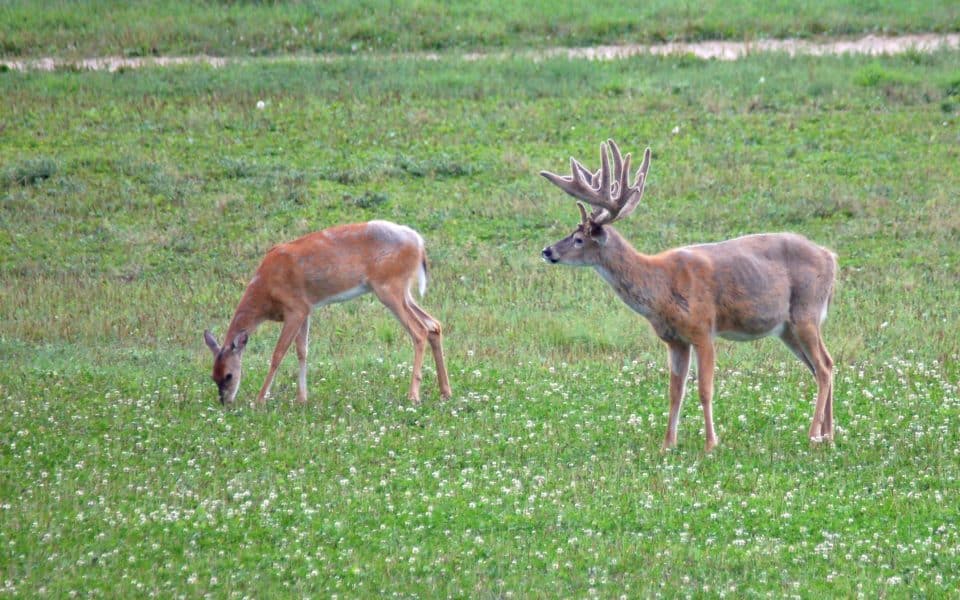With growing concerns of eating and living a healthier lifestyle, the word organic has become a buzzword in today’s society. But what does it really mean? How does it contribute to growing food, including how the ground is prepared, the food grown and eventually consumed? Also, how has it helped in the topic that most readers are concerned with of preparing and growing food plots for wildlife?
“In the beginning” organic farming is all there was. No synthetic man-made fertilizers, herbicides or pesticides. Jean Nick said in Better Planet, “Ever since the first hunter-gatherer chased away a flock of hungry birds that were eating something they wanted to harvest themselves, humans have been competing with other organisms for food.”
More gamekeepers nowadays are using fewer synthetic fertilizers, herbicides and pesticides. These chemicals, while maybe saving a little work, are not always the most healthy way to do things for the animals, our soils, the other plants in the area, and above all else, us. It’s happened numerous times – a new herbicide comes to market and ten or twenty years later we find out it causes cancer, birth defects or some other terrible impediment. While the natural way of doing things may not be the fastest, it is most often the healthiest.
The history of organic farming practices is interesting, but how can it help the average gamekeeper today? The use of cover crops may be the biggest way in which it can help you manage your ground.
Why Plant Food Plot Cover Crops
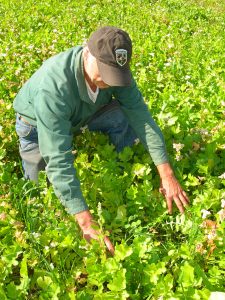
Todd Amenrud
Cover crops have the potential to provide multiple benefits in growing food plot crops. They can prevent soil and wind erosion, improve the soil’s physical and biological properties, supply nutrients, suppress weeds, improve the availability of soil water, break pest cycles and heighten biodiversity throughout a farm. The species of cover crop(s) selected along with how they’re managed typically determine the benefits and returns.
What type of cover crops you should use depends upon your goals. Some cover crops are great at taking up excess nutrients found in the soil; others are great at breaking up heavily compacted areas. Some help build organic matter or certain nutrients, and others are especially good at weed suppression. These goals, as well as other factors, will help to determine the best species to use. Your location north to south also factors into which plants will work best and for what. Just as with many food plot options, a “blend” of cover crop plants is better than a single cultivar.
Spring planted cover mixes are usually used to jumpstart your soil’s biology after a long winter. They are often used to prime the soil quickly, adding biological diversity ahead of a later planted spring crop. Moisture might be a concern, as you obviously want ample moisture available for your main spring crop and don’t want your early planted cover crop plants to soak it all in. However, moisture used up by the cover crop is usually gained back because of the increased water infiltration and decreased evaporation the cover crops bring to the party.
Early summer mixes are commonly used for biological diversity, weed suppression, nitrogen production, to attract pollinators, and to increase and cycle other nutrients. These blends can commonly include both cool-season and warm-season species.
Midsummer and late summer blends convert the ample energy from the sun into soil nutrients and organic matter. During midsummer, numerous species of plants can be used. Warm season species will be the bulk of the plant types in these mixes. Late summer blends will differ a bit because you’ll want to add more cool season choices. The warm season species will decline and die after the first killing frost, leaving the cool season species to continue.
Just as the term “fall planting” is often deceiving when it comes to food plot forages, we must also add a caveat here; in areas of the north, “fall planted cover crops” may actually be planted during the late summer and should be based off when your first frost typically occurs. About four to five weeks before your average annual first killing frost should give the plants ample time. Species that winter-kill at temperatures below 25°F should be considered carefully, while overwintering species are preferred.
Different types of cover crops can be broken down in different ways, but we’ll look at legumes, grasses, brassicas, various broadleaves and a few perennials. There are hundreds of cover crop choices – some of the favorites listed below were selected because they provide exemplary benefits to the soil and wildlife love most of them. You’ll notice that many of these plants are included in numerous BioLogic food plot blends.
Legume Food Plots

Holiday62
Legumes of some kind should be in just about every cover crop mix because of their symbiotic relationship with rhizobia bacteria and ability to fix nitrogen (N). We’ll talk about perennial legumes in a bit, here, were only referring to the annuals. A pure stand of only legumes can fix 120 to 180 pounds of N per acre! In a mix with other plants that obviously declines, but should still yield 30 to 80 pounds of N per acre. Whether an annual or perennial legume, most understand that legumes are usually high in protein and VERY palatable to wildlife.
Some of the best choices would include sunn hemp, mung beans, and soybeans for warm season choices. Good cool season selections consist of hairy vetch, spring peas, winter peas, balansa clover and arrowleaf clover. Most legumes will work well in a cover crop mix. Considerations that may come into play with any of the plant types would be at what temperature does it cold-kill, its drought tolerance, how much forage (biomass) does it produce, the quality of the forage and its tolerance to your soil’s pH.
Grass Food Plots
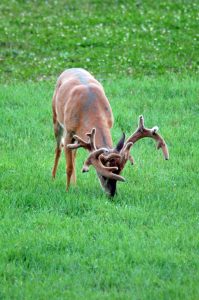
Todd Amenrud
Grasses are somewhat the workhorse of the cover crop realm, especially when considering cash-crop agriculture because they commonly produce the highest yields and greatest biomass. Many are very palatable to wildlife during certain stages of their growth, tend to be higher in their carbon to nitrogen ratio than other plant types, and can provide excellent organic residue for the soil.
Some of the best grass cover crops would include sorghums, millets, cereal rye, annual ryegrass, oats, triticale and winter wheat. Sorghums may deserve their own category. While it may not be as palatable or provide as much food to whitetails as certain other plant types, in the cover crop world, there is no more versatile or widely used plant family. Again, they should be broken down into warm and cool season selections. All the sorghums (including Egyptian wheat, which is a sorghum) and millets are warm season grasses. The cool season choices include many that we traditionally plant for whitetails like oats, winter wheat, triticale, cereal rye and annual ryegrass.
Brassica Food Plots
Most who manage their ground for whitetails know about these famous food plot plants because of the whitetails’ celebrated attraction for them. This alone would be a great reason to plant brassicas, but when they first came to the outdoor market back in the late-80s, few understood what amazing benefits they also held for the soil.
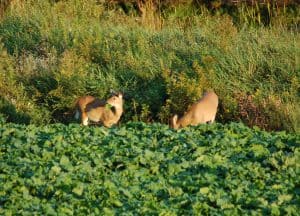
Todd Amenrud
Brassicas benefit the soil in many ways, but breaking up compacted soil, suppressing weeds, and allowing for water infiltration are three of their strong suits. When the high levels of the plants’ starches begin to turn to sugars, they then become possibly the best whitetail attraction of all time. As a hunter and gamekeeper, this is often the biggest reason to plant them.
There are no warm season brassica choices; these are all cool season plantings. At least that’s what they say…but when planted as a cover crop just to benefit the soil, you can really plant these anytime during the growing season that you have a little moisture to get the seeds off to a good start. When planted to be used for whitetail attraction for during the hunting season, then a late-summer or early-fall planting time will be best. After a couple years of planting them, once whitetails become accustomed to brassicas, they will eat several types anytime during the year.
At the absolute top of the list is the daikon radish, like those in BioLogic’s Deer Radish. Other great standouts would be purple top turnips and several varieties of rape, like those found in Winter Bulbs, Final Forage and several other BioLogic blends. Other good options would include kale, African cabbage, and several varieties of mustard.
Broadleaf Food Plots
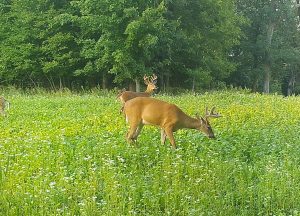
Dave Medvecky
The “broadleaf” category includes a wide array of plants. These are plants with leaves that have a flat, relatively broad surface, often marked with a network of obvious veins. Some are familiar vegetables, others many consider weeds, but their benefits to the soil can be great.
Buckwheat deserves top honors in this category. Many people think it’s a cereal grain like wheat or rye, however, it’s not a wheat, not a cereal and not a grass like the others. It is a fast establishing warm season crop that can be utilized in a wide array of mixtures. It germinates and covers the ground quickly, providing great weed suppression. Buckwheat attracts pollinators, it is a valuable phosphorus source, excellent “green manure,” and an overall great soil-builder. In addition, deer love it and turkeys and other birds relish the seeds once mature.
Other warm season choices would include sunflower, okra, squash, pumpkins or melons. Cool season broadleaf choices would include sugar beets, flax, and plantain. Chicory is also included in this category and deserves its own mention because of its ability to draw minerals from the soil and make them available to your whitetails (when they eat the plant), or for future crops when left to decompose. Just like the daikon radish, chicory also has a very deep taproot and is good a breaking up compacted soils.
Perennial Food Plots
A practice that was once a staple of sound crop rotation prior to the 1940s was a planting of perennial legumes, grasses and forbs. The English referred to it as a “ley crop.” This was before there was inexpensive synthetic nitrogen fertilizer, herbicides or pesticides. Back then, if you wanted a good yield from the soil, it was an essential practice to return cropland to pasture and then back again.
There are many advantages to this routine. First, it helped bank and pool available nitrogen so they could follow it with a corn crop. Second, it helped to restore organic matter and soil aggregation. Lastly, it reduced the prevalence of diseases, insects, and weeds.
Since most of us gamekeepers aren’t planting these things for a livestock pasture, we want a relatively quick soil improvement for a low cost. How quickly? Two to four years. Many of us would not deem that fast, however, when you consider the cost savings over using chemicals and how much better it is for the soil, others may consider it a no-brainer.
If you have enough ground devoted to food plots, it shouldn’t be a big deal to begin thinking in this “rotation-minded” approach. If you have limited acreage to devote, then it’s tough to set aside ground unless it’s providing your preferred wildlife species some immediate benefit. Luckily, many of these plants are some of the whitetails’, and other wildlife’s favorites.
Several BioLogic blends are made up entirely of plants that advance your soil, with Clover Plus being at the top of the list. Every plant in this perennial blend with benefit both, your soil and your wildlife. In general, white clovers, red clovers, alfalfa, sainfoin, and birdsfoot trefoil are good options. Forbs like chicory (that we mentioned above in the “broadleaf category,” but is also a perennial) plantain, and small burnett are good additions. Some grasses like tall fescue, perennial ryegrass or festulolium can also be added, however, these grasses really aren’t doing your whitetails much good if that’s your sole reason for the plot.
In addition to crop selection and rotation with soil health in mind, we should think about organic treatments and practices. As examples: using a roller/crimper to kill vegetation rather than herbicides, composting, and no-till planting rather than major soil disturbance.
Sometimes the “old ways” are best. Certainly, our technology with new chemicals that have been developed over the past century can make things a bit faster, but is it really the best approach? Adopting an organic approach is not just avoiding chemicals or synthetic controls it is applying some techniques that were used long ago, combined with what we now know is best for the soil, our wildlife, our wallets, and our future.

